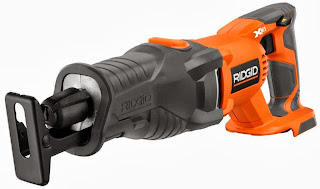Saw It All: How to choose a reciprocating saw
If you've never used a reciprocating saw, you might wonder whether you really need one, especially if you have a good circular saw and an assortment of handsaws. But if your project involves any kind of renovation or remodeling work, the answer is an unqualified yes.With a reciprocating saw, you can quickly cut out old framing and sheathing to make way for new doors and windows, and with the right blade you'll be able to power through pipes, nails, shingles, and wires, sometimes all at once. A true professional's tool, reciprocating saws will get you into places to make cuts that can't be made with any other type of saw.
Saw History: I Came, I Sawzall'd, I Conquered
Back in 1951, the Milwaukee Electric Tool Corporation introduced an electric saw that mimicked the back-and-forth motion of a handsaw rather than relying on the rotary cutting action of a circular saw blade. This early Sawzall, as reciprocating saws are still often called, was pretty basic: a metal case containing a 4 amp motor controlled by a simple on/off trigger. I have one of these machines, and it's been a reliable and indestructible companion over the years. But I have to admit that in my heart, I lust after one of the new generation of reciprocating saws: they're more powerful; they have bigger strokes (the distance traveled by the blade); they provide more strokes per minute, so that they cut faster; and they offer features that give them more precision and versatility like variable speeds and orbital action.Main Features
You might think that the primary consideration when choosing a reciprocating saw is sheer power, as measured by motor amperage. In general, bigger motors and they range in size from 4 amps to 11 amps, offer more cutting power.But unless you are hogging out holes all day long, there are other factors that are equally important:
- Cordless options: For occasional use, one of the new 18-volt cordless reciprocating saws might suit your needs perfectly.
- Orbital action: Some saws now offer orbital action, a feature that makes the blade cut more aggressively because it actually pushes the blade into the cut, although the resulting cut is more ragged.
- Adjustable shoe: The shoe is the front part of the saw that braces it against the workpiece. On some saws the shoe can be moved to expose different parts of the blade. Moving the shoe adjusts the depth of cut, which can be handy when you need to cut out a stud but don't want to cut into the sheathing behind it. Some shoes can be adjusted simply by moving a lever, while others require the use of wrenches.
- Variable speeds: One of the biggest improvements to reciprocating saws occurred when manufacturers began offering variable speeds. This gives you more control in tricky cutting situations, such as when you are trying to ease a plunge cut into wood or are cutting through metal. In some cases, the saw has a single speed range controlled by a simple variable-speed trigger; in other cases, the saw has both a low (for cutting metal) and high range controlled by a switch on the body of the saw. There are other variations too, including dial speed controls and simple two-speed switches.
